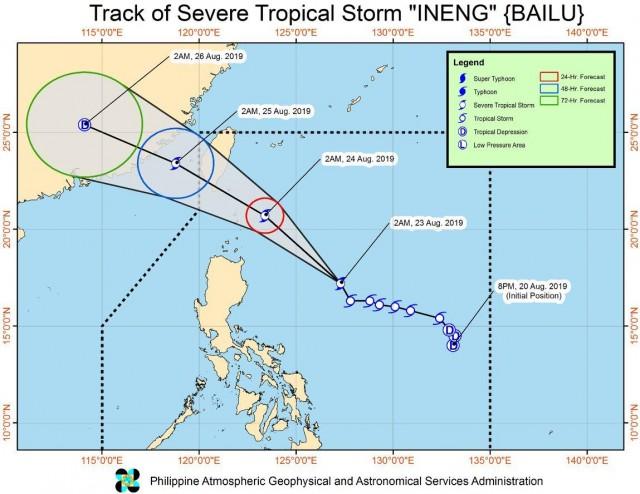Ineng now a Severe Tropical Storm, Signal No. 2 raised over Batanes

Ineng has intensified and is now classified as a Severe Tropical Storm, PAGASA reported in a Severe Weather Bulletin issued early Friday morning.
As of 4 a.m., the center of Severe Tropical Storm Ineng was estimated at 580 kilometers east of Tuguegarao City, Cagayan packing maximum sustained winds of up to 95 kilometers near the center and gustiness of up to 115 kph and moving north-northwest at 20 kph.
Tropical Cyclone Wind Signal TCWS No. 2 has been raised over Batanes.
TCWS No. 1 is raised over Cagayan including Babuyan Group of Islands, Isabela, Apayao, Kalinga, Northern Abra, and Ilocos Norte.
Ineng remains less likely to make landfall over any part of the country and is expected to exit the Philippine Area of Responsibility (PAR) between Saturday late evening and early morning on Sunday.
Moderate to heavy rains may be experienced over Batanes, Cagayan (including Babuyan Group of Islands), Ilocos Norte and Apayao. Light to moderate with intermittent heavy rains may prevail over Metro Manila, Central Luzon, Cavite, Batangas, Mindoro Provinces, northern portions of Palawan (including Calamian and Cuyo Islands), and the rest of Ilocos Region, Cordillera Administrative Region and Cagayan Valley.
On Saturday, moderate to heavy rains may be experienced over Ilocos Region, Cordillera Administrative Region, Batanes, Cagayan (including Babuyan Group of Islands), and Mindoro Provinces. Light to moderate with intermittent heavy rains may prevail over Central Luzon, Cavite, Batangas, northern portions of Palawan (including Calamian and Cuyo Islands), Aklan, Antique, Iloilo, Guimaras, and the rest of Cagayan Valley.
Residents in the affected areas, especially those living in areas identified to be highly or very highly susceptible to floods and rain-induced landslides, are advised to take precautionary measures, coordinate with local disaster risk reduction and management offices, and continue monitoring for updates.
Sea travel is risky over the seaboards of areas under TCWS and the eastern seaboards of Central Luzon, Southern Luzon, and Visayas due to potentially rough sea conditions. — BAP, GMA News



